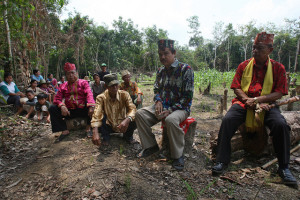Originally published at CIFOR’s Forests News

Research on climate change and forests is at the heart of the CGIAR Research Program on Forests, Trees and Agroforestry (FTA). A recent study that came out of FTA research outlines challenges for REDD+ measures, i.e. projects towards Reducing Emissions from Deforestation and Forest Degradation, at the local and national level. Tara Lohan spoke to the authors of the study Multilevel governance challenges in transitioning towards a national approach for REDD+: evidence from 23 subnational REDD+ initiatives
At the international level, global leaders are continuing to discuss how to develop and implement national REDD+ strategies. At the same time, pilot programs to reduce deforestation are already in place at the local level in many countries.
These can seem like two disconnected processes, according to Ashwin Ravikumar, a postdoctoral fellow at the Center for International Forestry Research (CIFOR). Ravikumar is the lead author of a new study from CIFOR that seeks to bridge this information gap between national and local work and to better relay key learnings.
The report has two key components. The first looks at whether proponents of jurisdictional and project-based initiatives relate differently to subnational policies. The second uses interviews with proponents of subnational projects to see how they have been helped or impeded by policies at the national or subnational levels, as well as how their work locally helps improve national policies.
Drawing comparisons

Researchers analyzed information from 23 REDD+ initiatives in Brazil, Peru, Indonesia, Tanzania, Cameroon and Vietnam. Project proponents ranked the difficulties that arose across seven arenas of subnational policy. Researchers then examined the differences in responses between those who were proponents of jurisdictional programs and those who espoused project-based initiatives.
“One of the advantages of a jurisdictional approach, in theory, is that it houses the purview of environmental stewardship and economic development, along with ostensible mechanisms of accountability, in one place,” said Ravikumar. “You’d expect that proponents from jurisdictional programs would be quite happy with policies from their own jurisdictions.”
Yet surprisingly, Ravikumar said, this was not the case.
“Our evidence suggests that the conventional wisdom that jurisdictional approaches make it easier to solve these types of political issues may not be well founded,” he said.
Proponents from jurisdictional programs actually found the policies from their own jurisdictions more challenging compared to project-level counterparts. Subnational policies in agriculture, trade, tenure and land use, investment and aid were all ranked more challenging by the former.
“The finding that jurisdiction-level proponents saw this as more challenging than NGO and private sector project proponents may suggest that those who are more embedded in these political systems see the problems more acutely, while the scale of projects may be small enough to avoid some of this complexity,” said Anne Larson, co-author of the study and a principal scientist at CIFOR.

Multilevel governance challenges
The research also summarized the results of interviews with subnational initiative proponents on policies at the national or subnational levels, in terms of how their projects were helped or hindered by national governments.
“We asked people where they perceived challenges, opportunities and risks in each of these areas and about mutual influence between national and subnational policies and their projects on the ground,” Ravikumar said.
REDD+ relevance
Four main policy areas relevant to REDD+ were examined.
“The results demonstrate a variety of specific challenges and opportunities across the six countries and the importance of multilevel governance considerations in the transition to a national REDD+ system,” said Larson.
The first area focused on monitoring, reporting and verification of reducing carbon emissions. Researchers found that measuring carbon has been very difficult to coordinate across governance levels, in part because maps and measurements used in different places are inconsistent.
The second area examined local policies and strategies to distribute benefits from REDD+ since no one has yet developed a harmonized system at the country level. Instead, Ravikumar said there is more of an ad hoc system in place where projects each design their own systems. However, this is not always seen as a bad thing, especially in countries with corruption at the national level.
The third area focused on land use policy, such as government subsidies for reforestation or incentives for cash crops that can either reduce or promote deforestation. Researchers found horizontal and vertical coordination problems between the multiple government offices and ministries with overlapping purviews or outright contradictory objectives.
“It is not uncommon to have a payment for environmental services program that rewards conservation, on the one hand, and on the other hand, massive subsidies for agriculture for cash crops that make it very attractive to deforest,” said Ravikumar. The result is that different ministries are often working against each other.
The final area looked at safeguards that aim to address the social and environmental effects of the programs – specifically, how policies may affect women, livelihoods, social justice and biodiversity.
“Proponents generally believe they are in a position to elevate the concerns of local people to national-level policy discussions, but it is also important that local people participate in and choose their own representatives in these processes,” said Larson.











